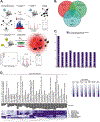Loss of ER retention motif of AGR2 can impact mTORC signaling and promote cancer metastasis
- PMID: 30575818
- PMCID: PMC7523706
- DOI: 10.1038/s41388-018-0638-9
Loss of ER retention motif of AGR2 can impact mTORC signaling and promote cancer metastasis
Abstract
Anterior gradient 2 (AGR2) is a member of the protein disulfide isomerase (PDI) family, which plays a role in the regulation of protein homeostasis and the unfolded protein response pathway (UPR). AGR2 has also been characterized as a proto-oncogene and a potential cancer biomarker. Cellular localization of AGR2 is emerging as a key component for understanding the role of AGR2 as a proto-oncogene. Here, we provide evidence that extracellular AGR2 (eAGR2) promotes tumor metastasis in various in vivo models. To further characterize the role of the intracellular-resident versus extracellular protein, we performed a comprehensive protein-protein interaction screen. Based on these results, we identify AGR2 as an interacting partner of the mTORC2 pathway. Importantly, our data indicates that eAGR2 promotes increased phosphorylation of RICTOR (T1135), while intracellular AGR2 (iAGR2) antagonizes its levels and phosphorylation. Localization of AGR2 also has opposing effects on the Hippo pathway, spheroid formation, and response to chemotherapy in vitro. Collectively, our results identify disparate phenotypes predicated on AGR2 localization. Our findings also provide credence for screening of eAGR2 to guide therapeutic decisions.
Conflict of interest statement
Figures






References
-
- Liu D, Rudland PS, Sibson DR, Platt-Higgins A, Barraclough R.Human homologue of cement gland protein, a novel metastasis inducer associated with breast carcinomas. Cancer Res. 2005;65:3796–805. - PubMed
-
- Patel P, Clarke C, Barraclough DL, Jowitt TA, Rudland PS, Barraclough R, et al. Metastasis-promoting anterior gradient 2 protein has a dimeric thioredoxin fold structure and a role in cell adhesion. J Mol Biol. 2012;425:929–43. - PubMed
Publication types
MeSH terms
Substances
Grants and funding
LinkOut - more resources
Full Text Sources
Research Materials
Miscellaneous

